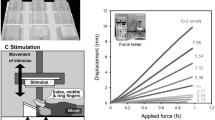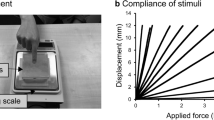Abstract
What is the apparent softness of a grasped object composed of two compliant materials? Experimental data indicates that perceived softness of a composite object depends on how the object is grasped and how it is oriented. If the object is grasped with a precision grip using index and thumb, turning around the object leads to a consistent change in overall perceived softness. Namely, the composite object seems softer when the index is in contact with the more compliant material than when it is in contact with the stiffer material. Importantly, such a difference in perceived softness due to object orientation is not present when the precision grip is obtained by opposing index and middle fingers to the thumb.
Access this chapter
Tax calculation will be finalised at checkout
Purchases are for personal use only
Similar content being viewed by others
References
Bergmann Tiest, W.M., Kappers, A.: Cues for haptic perception of compliance. IEEE Trans. Haptics 2(4), 189–199 (2009)
Chen, J.-S., Srinivasan, M. A., Massachusetts Institute of Technology. Research Laboratory of Electronics, Massachusetts Institute of Technology. Laboratory of Human and Machine Haptics: Human Haptic Interaction with Soft Objects. Research Laboratory of Electronics, Massachusetts Institute of Technology, Cambridge (1998)
Di Luca, M.: Perceived compliance in a pinch. Vision. Res. 51(8), 961–967 (2011)
LaMotte, R.H.: Softness discrimination with a tool. J. Neurophysiol. 83(4), 1777–1786 (2000)
Plaisier, M.A., Ernst, M.O.: Two hands perceive better than one. In: Isokoski, P., Springare, J. (eds.) EuroHaptics 2012, Part II. LNCS, vol. 7283, pp. 127–132. Springer, Heidelberg (2012)
Scilingo, E.P., Bianchi, M., Grioli, G., Bicchi, A.: Rendering softness: integration of kinesthetic and cutaneous information in a haptic device. IEEE Trans. Haptics 3(2), 109–118 (2010)
Srinivasan, M.A., LaMotte, R.H.: Tactual discrimination of softness. J. Neurophysiol. 73(1), 88–101 (1995)
Tan, H.Z., Durlach, N.I., Beauregard, G.L., Srinivasan, M.A.: Manual discrimination of compliance using active pinch grasp: the roles of force and work cues. Percept. Psychophysics 57(4), 495–510 (1995)
Acknowledgments
This work was supported by the Royal Society research grant RG110521. The author thanks Markus Rank for his insightful comments and help with the manuscript. He is also grateful to Vera Mönther and Samuel Molyneux for conducting the experiments.
Author information
Authors and Affiliations
Corresponding author
Editor information
Editors and Affiliations
Rights and permissions
Copyright information
© 2014 Springer-Verlag Berlin Heidelberg
About this paper
Cite this paper
Di Luca, M. (2014). Perceived Softness of Composite Objects. In: Auvray, M., Duriez, C. (eds) Haptics: Neuroscience, Devices, Modeling, and Applications. EuroHaptics 2014. Lecture Notes in Computer Science(), vol 8618. Springer, Berlin, Heidelberg. https://doi.org/10.1007/978-3-662-44193-0_17
Download citation
DOI: https://doi.org/10.1007/978-3-662-44193-0_17
Published:
Publisher Name: Springer, Berlin, Heidelberg
Print ISBN: 978-3-662-44192-3
Online ISBN: 978-3-662-44193-0
eBook Packages: Computer ScienceComputer Science (R0)




